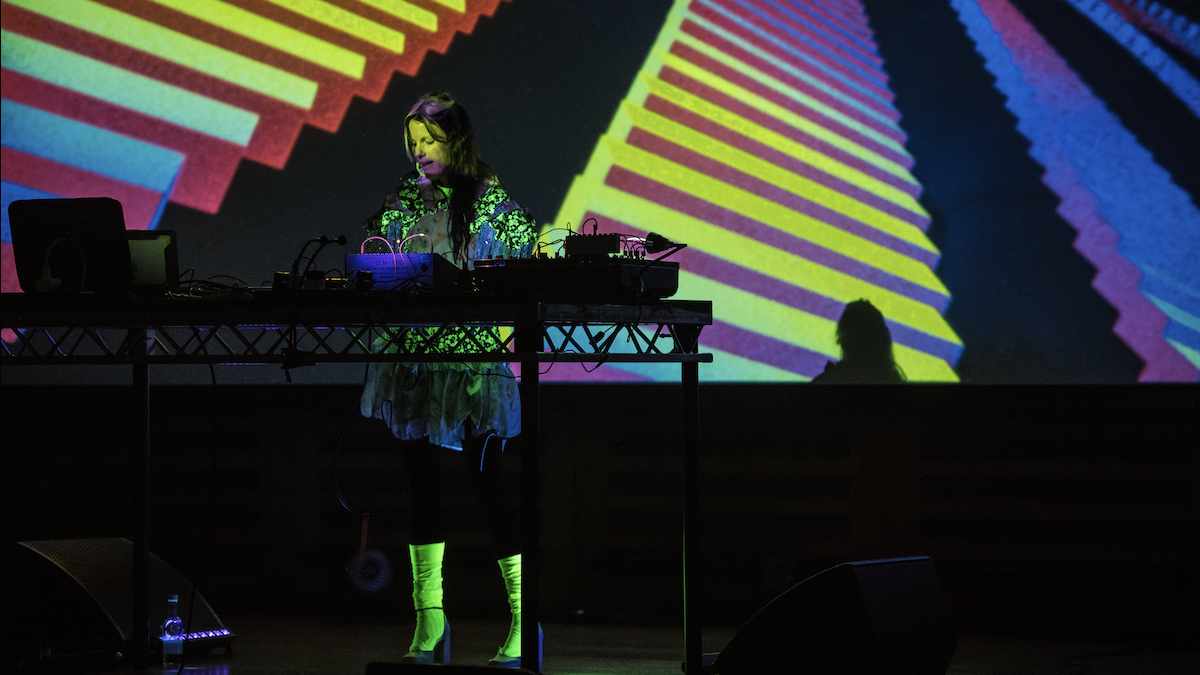Features
Modular Pop – Kaitlyn Aurelia Smith in Europe

Mark Jenkins meets a modular and (maybe) techno-pop innovator
Kaitlyn Aurelia Smith is one of the new generation of modular synth musicians. She lives in Los Angeles, but her music is taking her all over the world for live performances.
Over the last decade her style has varied massively, taking in abstract and experimental music, minimalism, analog-sounding space music, and most recently a new hybrid style somewhere close to techno-pop.
Her current album “Let’s Turn It Into Sound” on Ghostly International has been tied in with striking visuals to create a show that is semi-composed and semi-improvised. In London she was giving two performances on the same day, which as she said could potentially be significantly different.
“It’s always a performance of the album, but there’s some flexibility. I work on my live performance sets for about a year until they’re entered muscle memory. So although I’m basically performing the album, there’s always room for some improvisation too.”
Kaitlyn has always worked with Buchla modular systems after being loaned one that was sitting unused in a neighbor’s barn on Orcas Island in Washington state. After getting to know the system she heard about Buchla pioneer Suzanne Ciani, who was living in the same small town.
The duo created some recordings released as “Sunergy“ in 2016. “Those were completely improvised sessions, which we worked on and then finally recorded. And our two systems were interfaced together, just using the banana plug system of the Buchla. I don’t even remember now exactly how we patched it – but there were various types of modulation going on from one system to the other, and sequencers locked together.”
By sticking mainly to the Buchla system, Kaitlyn resists the worst effects of Gear Acquisition Syndrome. “I just have a small Eurorack system, but I expand by having several different Buchla systems, and various other keyboard and desktop synths. For example, I have an Oberheim Synthesizer Expander Module that I take with me for live shows. When I go to perform in synthesizer museums like the Melbourne Electronic Sound Studio in Australia and the Vintage Synthesizer Museum in Los Angeles, I patch into their instruments too. It’s really great that these places are preserving the rare ones – what I call the unicorn synths, instruments I could never afford.”
For the current shows Kaitlyn has collaborated with visual artist Sean Hellfritsch (@Cool Maritime). “I wore a motion capture suit [the Smartsuit Pro by Rokoko], and that helped create the movement of the central character in the visuals, a sort of story teller figure for each track. And then the live music system can influence the speech and motion of that figure – you really have to see the show to appreciate how it all works.”
For live shows Kaitlyn carries the Buchla Music Easel. “That’s the portable one, it fits in baggage easily and has the touch keyboard. So for these shows I’m going all around the UK and then on to Europe, about a dozen shows in three weeks around the UK and in Belgium, France, the Netherlands, and Germany.”
Kaitlyn’s original training, including at Berklee College of Music, was classical (she also appeared in an indie folk group early on) and there’s a great deal of “pianistic” performance in the live show. She can play swift keyboard figures and arpeggios, then punch them in to play back as a sequence. “It keeps me busy during the show, so there’s lots of movement.”
She’s also singing into a headset mic, but what comes out isn’t a simple vocal – it arrives as multiple harmonized layers that can be pitch-shifted from the modular system. “But I’m keeping exactly how that’s a done a secret for the moment, it’s something I’m still working with,” she explains with a smile.
Journey through the videos on Kaitlyn’s website, and you’ll find a wide divergence of styles. An initial influence was the repetitive minimalist music of Terry Riley ,and there are many similar elements – as well as more abstract ones – in her early modular system work, often accompanied with videos shot by talented film makers.
As her approach to modular systems became more sophisticated, the music became more multi-layered, swirling with analog sound textures reminiscent of Bernard Xolotl, Constance Demby, and the other pioneers of American space music.
But more recently the sound has hardened up with the inclusion of many sampled loops, repeated percussion, and other effects. The live show for “Let’s Turn It Into Sound” is immediately attention-grabbing in the same way as a performance by Skrillex or Grimes, or maybe the multi-lingual K-pop girl group Blackpink. It’s not pop, it’s not techno-pop, though it has many elements from those styles, but sliced very much more finely.
When almost Cuban Latin rhythms and sampled (or re-created) textures of layered saxophones appear, you could be listening to an early Philip Glass wind quartet, but only for a few seconds before the feeling is swept away by something else.
Kaitlyn wears a translucent outfit within which tiny colored LED lights shine and sparkle. Her swaying dance moves, neon accessories that shine under the UV light, and pitch shifted vocals make her seem like an entertainer from Blade Runner, pulling in elements of music from all over the world, from the past and from the future. The central character in the animations sings and dances solo or in duos and trios, expressing isolation, togetherness, reflective or expansive emotions.
Kaitlyn’s UK and European shows are continuing at the time of writing. Show details as well as links to the “Let’s Turn It Into Sound” album are on the website. That link is also where you’ll find a photo gallery, studio performances, videos, and tour dates.
–




















